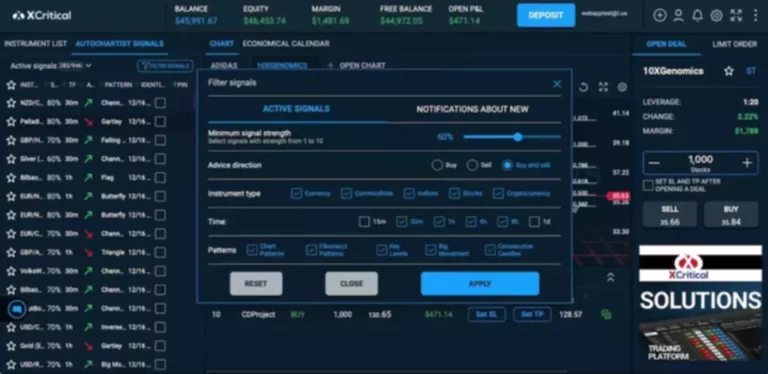Content
For the most effective market analysis, technical and fundamental Analysis should be combined to understand trends and reversals fully. Technical Analysis helps identify good entry points to enter trends and exit points to take profits. Traders determine optimal levels to enter and exit trades by analyzing support and resistance, trend lines, and price reversals. Backtesting involves applying a trading strategy to historical data to indicator tools for trading evaluate its effectiveness.
What’s the Difference Between Fundamental and Technical Analysis?
- Volume is often overlooked but is an essential component of technical analysis.
- Hundreds of patterns and signals have been developed by researchers to support technical analysis trading.
- While some patterns and indicators perform well in bullish markets, others may be more suited to bearish or sideways markets.
- Each chart type provides a unique perspective on market dynamics, offering valuable insights into trends, support and resistance levels, and price patterns.
- There are numerous technical indicators (e.g., moving averages, RSI, MACD), and analysts must decide which ones to use and how to configure them (e.g., time periods, thresholds).
Since all traders have access to the same market information, and many of them are using the same technical analysis tools, there is also an element of self-fulfillment in technical predictions. Technical analysis can https://www.xcritical.com/ be used to trade stocks, particularly in the short term. For example, day traders might buy and sell stocks to take advantage of short-term pricing anomalies that are identified using technical analysis. In technical analysis, chart patterns appear on price charts when they create a recognizable shape.
What are some advantages and disadvantages of fundamental analysis?
Technical analysis is the use of historical market data to predict future price movements. Using insights from market psychology, behavioral economics, and quantitative analysis, technical analysts aim to use Decentralized finance past performance to predict future market behavior. The two most common forms of technical analysis are chart patterns and technical (statistical) indicators.

Fundamental Analysis vs. Technical Analysis

In this section, we’ll look at quotable insights from well-known analysts and also explore academic and professional research on the subject. As we venture into the world of technical analysis, it’s crucial to get acquainted with its foundational concepts. This section will provide an in-depth look at the building blocks that make up technical analysis. From the relevance of historical data to the key tools used by practitioners, we’ll cover all the bases to set you on the path of becoming an informed trader or investor.
Charting and technical analysis
On the flip side, critics often point to the Efficient Market Hypothesis (EMH) as a counterargument against technical analysis. According to EMH, all available information is already reflected in asset prices. Therefore, it’s impossible to consistently outperform the market through any analysis (technical or fundamental). To make sense of the vast amount of data points and charts, traders use various indicators and oscillators as tools to assist them in their analysis.
Not just confined to the broader market, trend identification can be applied to individual securities, sectors, or even commodities. Riding a trend, especially in its early stages, can result in significant profits. This principle primarily revolves around the consistent aspect of market psychology.
Technical Analysis helps determine appropriate stop-loss levels to limit risk and target levels to book profits on trades. Traders anticipate where the price may reverse and set stop losses by analyzing critical support and resistance levels. The ability to correctly identify a trend and predict trend reversal is a crucial part of technical Analysis.
Be patient with your progress and persistent in your efforts to expand your knowledge and improve your skills. By keeping these considerations in mind, you can effectively learn technical analysis and enhance your ability to make informed trading decisions. An example of technical analysis in practice is using trend lines to identify support and resistance levels.
Without considering these fundamental elements, technical analysis may miss critical information that could influence market behavior. These criticisms highlight the limitations and potential pitfalls of relying solely on technical analysis for trading decisions. Moreover, the reliability of technical analysis can vary depending on the timeframe and the specific asset being analyzed. Short-term price movements can be highly volatile and subject to noise, making it challenging to distinguish between genuine signals and random fluctuations. Additionally, technical analysis often relies on historical data, which may not always be a reliable predictor of future performance, especially in rapidly changing markets.
Technical analysis is the reading of market sentiment via the use of graph patterns and signals. Various empirical studies have pointed to its effectiveness, but the range of success is varied and its accuracy remains undecided. It is best to use a suite of technical tools and indicators in tandem with other techniques like fundamental analysis to improve reliability. Traders use technical indicators to gain insight into the supply and demand of securities and market psychology.
To know volatile periods, traders can use volatility indicators, which help to reveal periods of high and low volatility of a particular stock’s assets or the whole market. Some main types of technical indicators include trend following, oscillators, volatility, and support and resistance, which are grouped based on their function. Technical analysis (TA) can be a helpful tool for making investment decisions and increasing the profitability of your trades. Even though technical analysis follows predefined rules, the results can be interpreted in many ways and are often subjective. This guide offers an in-depth explanation of the technical analysis, clarifies its premises, and compares it to other methods. Moreover, it highlights how to master and use TA to your advantage to improve the profitability of your investments.
By combining both approaches, investors can achieve long-term growth while also taking advantage of short-term price fluctuations. Fundamental analysis is a long-term approach to examining a company’s financial health and future potential. Additionally, technical analysis is susceptible to false signals, resulting in poor investment decisions. Then, other traders will see the price decrease and sell their positions, reinforcing the strength of the trend.
Simple Moving Averages (SMA) are calculated by adding the closing prices for a set number of periods and then dividing the sum by the number of periods. Moreover, there is also a lot of education material online that is free of charge if you are tight on budget. Still, one of the best and fastest ways to learn is to seek out professional traders who could teach you personally one-on-one.
Lastly, the self-fulfilling prophecy effect, where many traders acting on the same technical signals can influence market prices, creates an illusion of accuracy that doesn’t hold up under rigorous scrutiny. In conclusion, technical analysis is a powerful tool that can help traders and investors make informed decisions in the complex world of financial markets. By focusing on the technical aspects of trading, such as price movements, volume, and chart patterns, technical analysis provides insights into market trends and potential trading opportunities. In contrast to fundamental analysis, which primarily focuses on a company’s financial health and economic indicators, technical analysis examines past market data to forecast future trends. With the foundational knowledge provided in this article, traders and investors can begin to incorporate technical analysis into their investment strategies and gain a deeper understanding of market dynamics.
Adam Hayes, Ph.D., CFA, is a financial writer with 15+ years Wall Street experience as a derivatives trader. Besides his extensive derivative trading expertise, Adam is an expert in economics and behavioral finance. Adam received his master’s in economics from The New School for Social Research and his Ph.D. from the University of Wisconsin-Madison in sociology. He currently researches and teaches economic sociology and the social studies of finance at the Hebrew University in Jerusalem. If you want to learn technical analysis, find a good online course and spend time reading free available online sources.
Leave a Reply